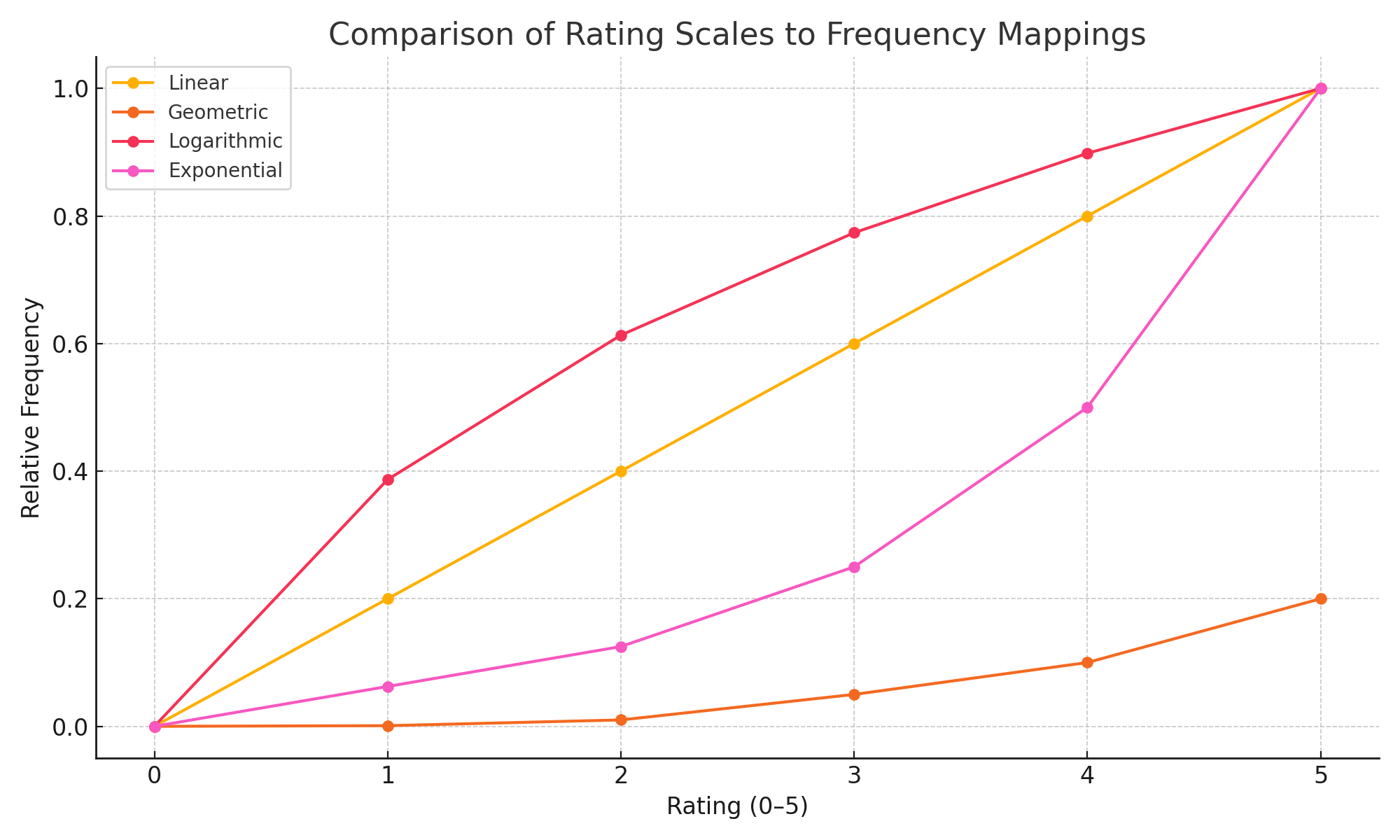I’ve been thinking about rating systems for humans. Not just how we evaluate things in the moment, but how we want those evaluations to shape what we encounter again in the future.
It started with a conversation about music. My wife and I were discussing how to rate songs in a way that felt both intuitive and useful. A 1 to 10 scale felt overly nuanced, too many options with too little distinction. A 1 to 3 scale was too coarse. We landed on 1 to 5 as the sweet spot. As a computer scientist, I briefly considered 0 to 4, but that’s not how most people think. Still, the idea of having a “0” stuck with me.
So what does a 0-5 rating scale mean?
I started framing it not just as how much I like a song, but how often I want to hear it again. Here’s where I landed:
- 0: I never want to hear this again. Block it completely.
- 1: I can tolerate it maybe once in a thousand times, just for variety.
- 2: It’s fine, rarely. Maybe once in a hundred.
- 3: I’d enjoy this once in a while, say, one in twenty plays.
- 4: This is good. Play it regularly.
- 5: I want to hear this a lot, every few tracks is fine.
This turns a subjective scale into something operational. It becomes not just a statement of preference, but a policy on repetition.
Why not 6? Or why not cap it at 4?
I considered whether a rating system should include a “6”, a statement that this is all I ever want to hear. But that quickly falls apart. That kind of tunnel vision lands you in a loop you can’t escape from. You’d end up in a feedback chamber with no variety or evolution. The opposite extreme is clearer: there should be a hard no. A zero gives people the ability to say, with certainty, “I never want to see or hear this again.” That’s different from a one, which still allows for occasional resurfacing.
Human perception isn’t linear
Once I started mapping ratings to frequency, it became clear that a linear approach doesn’t reflect how people experience things. The difference between a 1 and a 2 is massive compared to the difference between a 4 and a 5.
The jump from “barely tolerable” to “sometimes fine” should be large, while the jump from “I like it” to “I love it” is smaller. This suggests we need a non-linear mapping, something more geometric or even exponential.
Here’s a chart that compares four ways to model rating-to-frequency mappings:

This helps illustrate the point. A linear scale fails to capture the emotional and experiential difference between low and high ratings. A geometric or exponential scale feels more appropriate, where the upper ratings represent dramatically higher preferences.
Sampling frequency, not absolute value
Another angle here is that these ratings aren’t about what’s good or bad in isolation. They’re about how often I want this thing in my life. That’s a different kind of signal.
If we assign weights to each rating, we can build a sampling model:
| Rating | Probability Weight | Target Frequency |
|---|---|---|
| 0 | 0 | Never |
| 1 | 0.001 | 1 in 1,000 |
| 2 | 0.01 | 1 in 100 |
| 3 | 0.05 | 1 in 20 |
| 4 | 0.10 | 1 in 10 |
| 5 | 0.20 | 1 in 5 |
These weights aren’t precise, they’re just a conceptual starting point. But they help clarify what the ratings mean in terms of behavior.
Open Questions
This model opens up a number of interesting threads to explore:
- Should ratings decay over time as novelty fades?
- Should frequency mapping be static, or adapt based on history?
- Is it helpful to distinguish between “never” (0) and “only in rare circumstances” (1)?
- Should the scale reflect absolute preference, or preference in context?
- What about confidence in your rating? Is there value in separating how much you like something from how sure you are about that judgment?
- Can this model generalize to other things, news, podcasts, social feeds?
- What’s the right way to balance “favorites” with “serendipity” over time?
I’ll explore some of these in a follow-up post. For now, I’m starting with a simple scale and using it to shape the way I interact with music. It’s early, but already more intentional than just clicking thumbs up or skipping tracks.